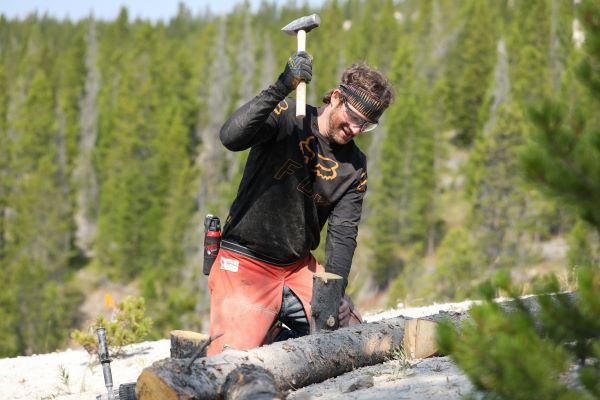RESTORING THE ECOSYSTEM AT BARREN SUGARLOAF PEAK

The barren top of Sugarloaf Peak towers above much of the Mount Haggin Wildlife Management Area, located southwest of Anaconda. The peak is painted red and milky white by loose soils on mostly unvegetated hillsides that contrast starkly with the conifer forest below. It’s been 141 years since smelting began in the area in
1883, and the landscape of the top of Sugarloaf is a lingering fingerprint left by anthropogenic influence during decades of mining, logging, and smelting.

Daniel Kelly (B.S. Biological Sciences, 2023) is a second-year graduate student in the Ecological
Restoration program at Montana Tech, working with Dr. Robert Pal. He explains the forest was logged to feed the smelters that processed the mining materials, and the smelter spewed toxic materials into the sky (aeolian contamination) that deposited onto the mountainsides near Anaconda; this made it nearly impossible for plant life to continue emerging and persisting. Over a century later, Sugarloaf Peak is still barren, and with every passing season of rain and snowfall, more sediment continues to pour off the mountain and into nearby streams.

“These are moonscape conditions,” Kelly said. “It just looks like white creamy moon soil and sedimentary material, and for quite some time now there’s been a lot of sediment deposited into California Creek, Mill Creek, Oregon
Creek, and other areas where we have these eroding steep slopes with very homogenous landscapes.” Heavy runoff of contaminated and noncontaminated sediments can disrupt aquatic life in the creeks. It’s a significant threat to macroinvertebrates and fish.

“I remember how fascinated Daniel was when we covered steep slope bioengineering techniques in our restoration classes,” Professor and Director of Restoration Robert Pal said. “He was eager to try them out on his own property,
which is near the current project site. That enthusiasm immediately showed us that he was a determined and proactive student, with great potential to apply these techniques in a research setting. With his drive, we were able to secure funding from the Natural Resource Program (NRDP) to move forward. I think he surprised us all with what he accomplished.”
Kelly is working to stabilize and retain the soil on the hillside and revegetate the area with native plants. He started a project in June that installed 412 so-called “modified brush layer” (MBL) log structures across seven locations at Sugarloaf Peak. To complete the project, Kelly cuts down nearby deadfall with a chainsaw. He then cuts the trees into smaller pieces measuring one to three meters in length. Kelly proceeds to do a layout for where the material will be placed as MBLs once it is cut into specified lengths. He then uses an auger to drill, place, then secure the “anchoring log,” with an 8- to 10-inch target to anchor the logs as deep as possible.
Once the anchoring logs are in place, Kelly proceeds to place the catchment log upstream to hold this critical component in place, matching the contour of the slope. The catchment log is what Kelly hypothesizes will assist in mitigating sheet erosion and will thus hold the highly mobile soil in place. The primary study site measures 100 meters by 25 meters. While the technique is not new, Kelly’s idea to anchor the logs is novel.
“Our primary objective is not only trying to hold that hillside together, but also to catalyze soil recovery, and revegetate those hillsides. It’s a multidimensional project,” Kelly said.
Kelly’s project is sponsored by the NRDP and is done with the permission of Montana Fish, Wildlife, and Parks, which manages the wildlife management area. The Big Hole Watershed Committee has provided crews to help
install the structures. Montana Conservation Crew volunteers completed gully work and members of Youth Employment Crew (YEP) out of Dillion also chipped in on labor. Kelly has plans to fertilize and conduct native seed
augmentation. He also did 20 live stakings of willow, aspen, and poplar trees.
In the short time between June and August, Kelly’s already seen new emergent native seedlings root themselves to the hillside. He points out sprigs of fireweed, lupine, Idaho fescue, and others with a big grin. The plants
appear to be making headway, centimeter by centimeter.
Kelly is a botanist at heart, and while he has to wait to scientifically evaluate his results, every tiny plant gives him hope that his project will help restore the environment near his hometown of Anaconda. Kelly does not have
any historical photos of Sugarloaf Peak to use as a reference for what a restored landscape should be, but he has a good idea of what progress would look like.
“I’m hoping in 5–10 years it looks nothing like the white, creamy conditions we are so
accustomed to,” Kelly said.
In his mind, he pictures a nice mix of native trees thriving, maybe even some of the rarer ones sometimes found nearby, like the threatened whitebark pine, Pinus albicaulis. There’s a robust understory of flowers and grasses. Most importantly, Kelly hopes the restoration method can be used to treat other areas facing the same problem.
“I hope we are able to scale this idea up to tackle more moonscape sites, if the structures
and approach works.”